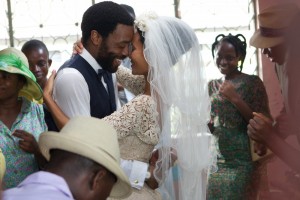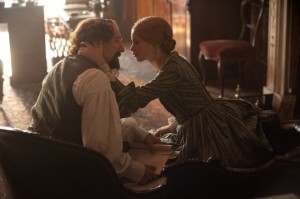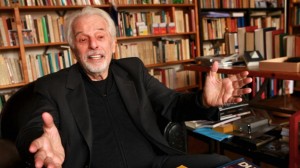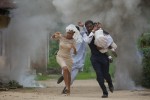AFI Fest, the American Film Institute’s annual film festival, continues at the Chinese Theatre in Hollywood. The Daily Bruin’s Sebastian Torrelio and Tony Huang are attending until the festival’s close on Thursday, when several of the biggest films being put up for audience award consideration will be screened. On the fourth day of AFI Fest, Torrelio took his turn to do a solo outing, seeing a few films that play with the conventions of retelling old stories to varying success, with messages humor, romance and drama.
 [media-credit name=”Slate Films” align=”left” width=”300″]
[media-credit name=”Slate Films” align=”left” width=”300″]
“Half of a Yellow Sun”
Directed by Biyi Bandele
Slate Films
A lot of the appeal for director Biyi Bandele’s debut feature, “Half of a Yellow Sun,” based on the novel by Chimamanda Ngozi Adichie, comes with its lead actor, Chiwetel Ejiofor, who is receiving an extreme amount of praise at the moment for his award-contending role in “12 Years a Slave.” It’s something of a blessing, giving Bandele an audience that otherwise surely wouldn’t have heard of his small project, including myself, after highly debating seeing another film about high stakes family drama. In the end, I believe my choice was the correct one, if not for anything but the absurdity.
Ejiofor plays the role of Odenigbo, the husband of Olanna (Thandie Newton), a simple man living in Nigeria who strikes a poor note with his wife early on in the film. The two spend the first half of the film fighting, getting revenge on one another, being lectured humorously by Odenigbo’s mother. Olanna’s sister Kainene (Anika Noni Rose) and her white husband (Joseph Mawle) encounter similar relationship problems during this time, albeit with less screen time.
Then, at about the halfway point of “Half of a Yellow Sun,” war breaks out. Reflecting the Nigerian Civil War of the late 1960s, the two families unite to support each other as their cities are frequently bombed and terrorized by soldiers. It’s a dramatic turn of events that is so shocking at times that it almost seems satirical, playing like a ridiculous new Africa-set Adult Swim show, but yet retains the film’s inner purpose and message without losing much in the transition.
There are very few films “Half of a Yellow Sun” can be compared to. Bandele mixed elements of war films with daytime soap operas, varying between overhead shots of small villages and competently built housing sets. In this way, the film is a success, but not in a way that anyone entering the theater would probably expect.
 [media-credit name=”Sony Pictures Classics” align=”left” width=”300″]
[media-credit name=”Sony Pictures Classics” align=”left” width=”300″]
“The Invisible Woman”
Directed by Ralph Fiennes
Sony Pictures Classics
The entirety of “The Invisible Woman” appears delicate. From the minimalistic score, only easing its way into the film with light strings after a tense moment, to its actors, comprised of a well-cast group of women who work exceedingly well as family members, Ralph Fiennes’ first directorial effort is executed as well as his vision, though not perfect, ideally appeared in his head.
The story revolves around two subjects, the charmingly playful and eloquent Charles Dickens, played by Ralph Fiennes himself, and Nelly Ternan, a young woman who aspires to act on stage, played by the always spot on Felicity Jones. Most of the film plays as a flashback, the older Nelly reminiscing about her young adulthood spent with her family alongside Dickens, fielding his frequent advances.
“The Invisible Woman” isn’t the most exciting movie, slowly combing over Dickens’ history like a biopic and referencing many of his plays and stories during his contemplative writing stages. It’s nothing that hasn’t been seen before, filling scenes with emotions, heartbreak and beautiful period costumes, but it is at least done very well. Using Dickens’ works to shine a negative light on him, Fiennes acts and directs with notable talent, embodying the persona of a craftsman aspiring to tell a story that, in the end, is worth its time.
 [media-credit name=”Sony Pictures Classics” align=”left” width=”300″]
[media-credit name=”Sony Pictures Classics” align=”left” width=”300″]
“Jodorowsky’s Dune”
Directed by Frank Pavich
Sony Pictures Classics
David Lynch’s “Dune,” the most well-known adaptation of the famous science fiction novel of the same name, is fairly insignificant, a messy, incoherent film that only succeeds in its imagery, a world as aspiring as it could have been circa 1984. It’s no wonder, then, that the movie at least partially originated as an idea in the head of Alejandro Jodorowsky, a Chilean-French filmmaker portrayed effortlessly in the documentary “Jodorowsky’s Dune” as a loveable mad genius.
In the early 1970s, after Jodorowsky had found some success with avant-garde films such as “El Topo” and “The Holy Mountain,” both of which retain venerable cult status even today, he aspired to make the most important movie of all time, and came heartbreakingly close. In an age before “Star Wars,” Jodorowsky had recruited the most surrealistic, talented gang of artists and actors he could find to produce his vision, only to be inevitably stifled by monetary barriers during production.
“Jodorowsky’s Dune” documents the entire story as told by Jodorowsky himself. He makes his mark as one of the most entertaining people depicted on any film at the festival, willing and open to discuss his imaginative dream, artistic developments and failure at the hands of the major studios in exceedingly funny detail.
In the end, the film is a convincing argument that the greatest movie of all time will always remain a fairy tale, though its legacy will live on in the inspiration that Jodorowsky spread throughout the industry, from classics such as “Blade Runner” and “Alien” to the piece that is likely the best documentary at the festival.
